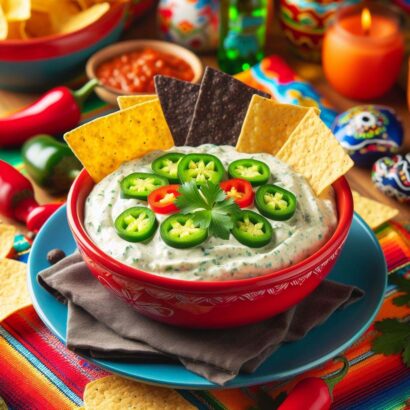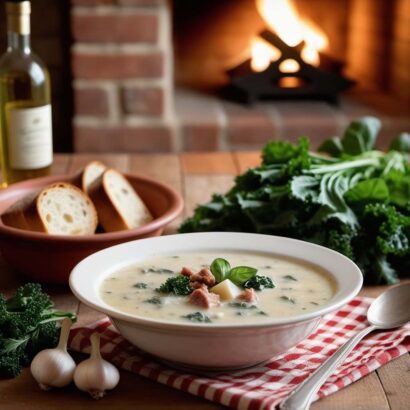Chicken and sausage gumbo is a classic dish that stands as a symbol of Southern hospitality and culinary excellence. Celebrated in homes and restaurants across Louisiana and beyond, especially during Mardi Gras and other festive occasions, gumbo’s versatility and comforting warmth have cemented its status as a beloved dish. Often served with rice to soak up its rich broth, chicken and sausage gumbo is prized for its savory depth and balanced flavors, making it a staple of Cajun cuisine and a testament to the region’s culinary prowess.
The origins of gumbo trace back to the 18th century, reflecting a rich cultural tapestry woven from French, Spanish, African, and Native American influences. Each of these cultures contributed their own ingredients and techniques, resulting in the unique and hearty stew known today. The term “gumbo” itself is derived from the West African word for okra, “ki ngombo,” highlighting the significant African influence on the dish. Originally, gumbo was a resourceful way to combine various available ingredients into a flavorful and sustaining meal, often incorporating seafood, poultry, and an array of vegetables.
The evolution of gumbo into its modern form, especially chicken and sausage gumbo, showcases the adaptability and creativity of Louisiana’s cooks. French settlers introduced the roux, a mixture of flour and fat used as a thickening agent, which became a foundational element of gumbo. Spanish colonists added their love for robust, flavorful sausages, while Native Americans contributed filé powder, ground sassafras leaves, as another thickening option. Over time, these elements combined to create a dish that is both deeply rooted in tradition and continually evolving, making chicken and sausage gumbo a cherished and enduring part of Southern cuisine.
One thing to understand about gumbo is that everyone makes it differently! Add ingredients you like, and leave out the ones you don’t! As long as you don’t burn your roux, it’s hard to make bad gumbo. Probably the biggest controversy is okra, a lot of people don’t like it because they think it’s slimy, and that’s okay it is perfectly fine to leave it out!
I like to start out cutting up all my vegetables and meats and have everything ready to go, because once the roux is cooking you won’t have time to step away, and when ingredients need to be added you can’t delay or the roux will burn.
A dutch oven works great for this, but any large pot will work. On medium heat, add andouille sausage slices and sear on both sides. Remove the sausage, but leave the drippings. Next, add the chicken and sprinkle the cajun / creole seasoning in, searing both sides. Remove once cooked, but again leave all the drippings! Some people like to cook their chicken thighs or breasts whole, then shred them afterwards. I think that is extra work, if you have to cut up the sausage might as well cut up the chicken too. However, I *have* been known to use some leftover rotisserie chicken, which I’ll shred by hand since it’s already cooked.
Now, in the same pot with the drippings from the sausage and chicken, reduce the stove to low to medium heat. Add the vegetable oil and flour, and start stirring! This step can’t be rushed, and don’t try to turn up the heat too high or you will burn the roux!
Stir frequently for about 20-25 minutes. First the roux will turn a peanut butter color, and you know you are getting close. Keep stirring until the roux is a light milk chocolate color, that’s your target. If you hit dark chocolate (or worse), you’ve burnt the roux and will need to start over.
As soon as the roux hits that milk chocolate color (or is very close), toss in the onions, celery, and bell peppers (aka the holy trinity) and continue to stir for 4 to 5 minutes, or until wilted. Then add back in your sausage & chicken, stir.
Slowly add the chicken broth while stirring until the roux mixture and broth are well combined. Add in the bay leaves and okra. Bring to a boil, then reduce heat to a simmer. Cook, partially covered, stirring occasionally, for at least 1 hour. Taste the gumbo and add additional salt if needed. Usually the cajun or creole seasonings already have a fair amount of salt in them, and depending on which sausage you use that probably has more salt too, so usually additional salt isn’t needed.
After the gumbo has cooked for an hour, remove from the heat. Stir in the parsley, green onions, and filé powder. Remove the bay leaves and serve! It is traditionally served in a bowl on top of white rice (which you have plenty of time to make while the gumo is simmering). I also like to serve with some crusty french bread or even small dinner rolls. You will want something to sop up every last bit of that delicious gumbo from your bowl!
If you can’t find filé powder at your local grocery store, don’t fret! It’s not super-critical, your gumbo will taste just fine without it! If you are having a hard time finding the traditional andouille or polish kielbasa sausage, don’t worry! Any smoked sausage will work, just grab what looks good to you!
Making gumbo is more about putting in the love than following an exact recipe!
Cajun Chicken and Sausage Gumbo
Equipment
- 8 qt Stock pot or Dutch oven
- Measuring cups and spoons
- Chef knife
- Cutting board
Ingredients
- 1 cup vegetable oil
- 1 cup all-purpose flour
- 1.5 cups onion chopped
- 1 cup celery chopped
- 1 cup green bell pepper chopped
- 1 lb smoked sausage cut into 1/2-inch pieces (Andouille or Kielbasa)
- 1 lb boneless chicken cut into 1-inch chunks (Thighs work best, but breast will work too)
- 2 tsp cajun or creole seasoning (Tony Chachere's, Slap Ya Mama, Zatarains, etc…)
- 1 tsp salt (Optional, add to taste)
- ¼ tsp cayenne pepper (Optional, for a little extra kick!)
- 2 bay leaf
- 6 cups chicken broth (Water works fine too)
- ¾ lb okra sliced (Fresh or frozen)
- ½ cup green onion chopped (Optional)
- 2 tbsp fresh parsley chopped (Optional)
- 1 tbsp filé powder
Instructions
- Make sure you have all your vegetables and meats cut up and ready. Making gumbo requires constant stirring until you add in all the chicken broth.A dutch oven works great for this, but any large pot will work. On medium heat, add andouille sausage slices and sear on both sides. Remove the sausage, but leave the drippings. Next, add the chicken and sprinkle the cajun / creole seasoning in, searing both sides. Remove once cooked, but again leave all the drippings!
- In the same pot with the drippings from the sausage and chicken, reduce the stove to low to medium heat. Add the vegetable oil and flour, and start stirring! This step can't be rushed, and don't try to turn up the heat too high or you will burn the roux!Stir frequently for about 20-25 minutes. First the roux will turn a peanut butter color, and you know you are getting close. Keep stirring until the roux is a light milk chocolate color, that's your target. If you hit dark chocolate (or worse), you've burnt the roux and will need to start over.
- As soon as the roux hits that milk chocolate color (or is very close), toss in the onions, celery, and bell peppers (aka the holy trinity) and continue to stir for 4 to 5 minutes, or until wilted. Then add back in your sausage & chicken, stir.
- Slowly add the chicken broth while stirring until the roux mixture and broth are well combined. Add in the bay leaves and okra. Bring to a boil, then reduce heat to a simmer. Cook, partially covered, stirring occasionally, for at least 1 hour. Add more water as needed. Taste gumbo and add additional salt if needed.
- Remove from the heat. Stir in the parsley, green onions, and filé powder. Remove the bay leaves and serve! It is traditionally served in a bowl on top of white rice (which you have plenty of time to make while the gumo is simmering).




